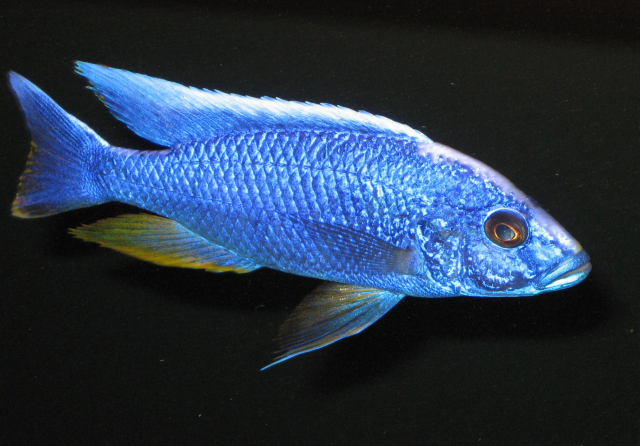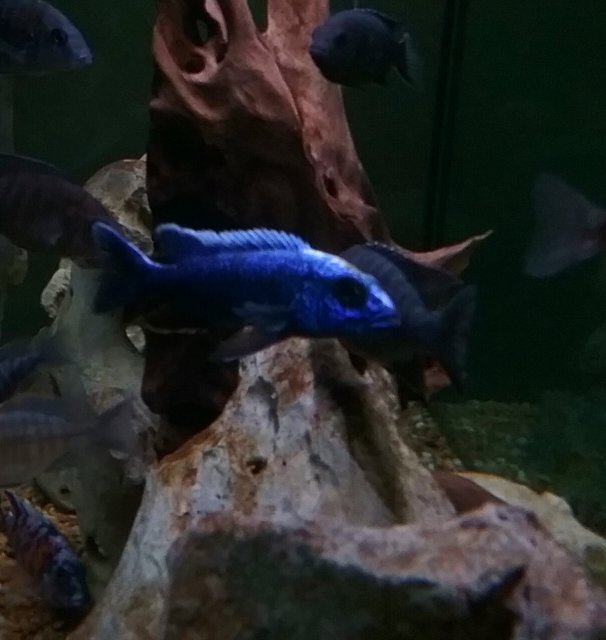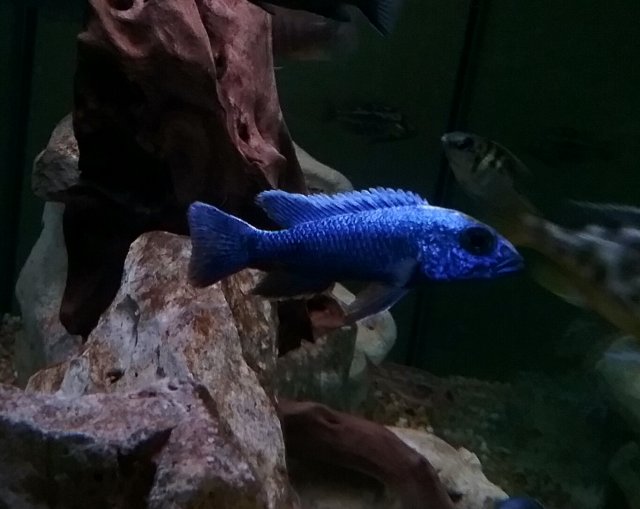If that's the case, I wonder if anyone has ever imported ahli? I believe Steve attempted many times and everytime they showed up as fryeri. I kept this fish back in the 90s when it was known as H. ahli, and then later changed to S. fryeri. I personally have never (I believe) to have ever seen them.
Sciaenochromis ahli vs fryeri
- Thread starter Com3backKid
- Start date
You are using an out of date browser. It may not display this or other websites correctly.
You should upgrade or use an alternative browser.
You should upgrade or use an alternative browser.
That's a good question. I have seen what I believed to be S. ahli once. The problem is I have no way in knowing with certainty, that they were indeed ahli. I can only say that they were labeled as such, and there were several males in the tank that were mature, or at least semi mature, and they did not look anything like any S. fryeri that I had seen over the years, and at that point I had seen probably hundreds of specimens, and owned a few myself. This was several yrs ago, at a LFS. The fish looked like pics that I have seen of ahli by Konings et al, more bland looking compared to what I would call a quality male fryeri. I would have asked questions, but the staff in that fish room are a rather uneducated lot. It may have been a rare fluke, or simply a poor strain of fryeri. Hard to say at this store, they rarely get rare fish, but it does happen from time to time.
Below is a pic I found of one of my males from years ago, I believe that this was a domestic bred fish, sold as S. fryeri.

Below is a pic I found of one of my males from years ago, I believe that this was a domestic bred fish, sold as S. fryeri.

I didn’t realize it was this deep.. I thought there would be physical traits to determine which was what.
That's a good question. I have seen what I believed to be S. ahli once. The problem is I have no way in knowing with certainty, that they were indeed ahli. I can only say that they were labeled as such, and there were several males in the tank that were mature, or at least semi mature, and they did not look anything like any S. fryeri that I had seen over the years, and at that point I had seen probably hundreds of specimens, and owned a few myself. This was several yrs ago, at a LFS. The fish looked like pics that I have seen of ahli by Konings et al, more bland looking compared to what I would call a quality male fryeri. I would have asked questions, but the staff in that fish room are a rather uneducated lot. It may have been a rare fluke, or simply a poor strain of fryeri. Hard to say at this store, they rarely get rare fish, but it does happen from time to time.
Below is a pic I found of one of my males from years ago, I believe that this was a domestic bred fish, sold as S. fryeri.
View attachment 1349314
GORGEOUS!!
Rd that fish resembles what I kept in the 90s. The original "electric blue" so to speak. The same fish that changed names. The odd thing is, seemingly over generations of breeding, both the tail and anal fins would become more red in color. I remember being obsessed with obtaining wild fish, or at least closest to what was available, and tried to get fish that were lacking in these traits despite their additional beauty.
I wish that I had pics of one of my earlier males, dark cobalt blue in color, and a rather red anal fin. Larry Johnson, a fellow Canuck has been diving in Lake Malawi every year for close to 20 years so I checked out what he has for photos of fryeri. Check out the color in this wild fryeri's anal fin, that fin stands out even in an underwater shot taken from above.
http://www.malawicichlidimports.ca/larry/Larry Johnson,2007 Lake Malawi Safaris pg6.htm

A Likoma Island fryeri listed as being wild caught.

Certainly everyone picks what they feel is the "best" looking breeders according to their personal view, so no doubt many males over the years have been chosen due to their flashy colors, such as red anal fins. So it doesn't surprise me to see more intense coloration in specimens that have been bred domestically over several generations.
The following fish are listed as wild caught S. ahli (not fryeri) so they clearly understand that there is a difference. I will also add these look very much like what I saw in the tank here locally a number of years ago. Lighter, more silvery, more bland, than what one would expect to see. The lighting and substrate may account for part of the lighter colors, but certainly not for everything. The fish I saw locally were in a dark setting, with black background. They were also darker than the fish in the vids below.
One last thing that I will add about availability from collectors on Malawi. I recently acquired some L. caeruleus "Ruarwe" that originated from a long time cichlid vendor here in Canada. I had never seen these before, not in person, not even on a list up here. They seem to be more rare in the US as well, and a decade ago I don't think one would have saw them anywhere in North America. Yet it seems in France they have been imported for many years. One person told me that a local importer in South Africa first had them as far back as 1997, yet up until possibly very recently Ad Konings had never even seen them in the wild.
A couple of years ago Larry Johnson commented about this variant on a well known cichlid forum where her stated:
"I have dove where this fish was supposed to be captured from at Ruware (2009), with Ad Konings. Ad was shown this color morph while in Europe doing a speaking engagment and was told where to find them,,,No luck so far, but I'm sure it's there.
You either go deep or shallow and I went deep,,,I thought I had observed one fry as it went into the rocks, but no pictures to confirm this.
Ruware is at the eastern tip/point of Usisya and I'm sure this place has been passed up as not being an area with "collectable fish". At the point there is a steep mountain there, and in similar area's usually continues straight down to the bottom indicating that the area is just deep water. What we found there on closer observation was a large shelf that levels off before going deeper which is unusual. 150 feet from shore and you are in well over 120 feet of water though.
I've passed this location many times since then and we just plain ran out of time to dive there.
I'm sure they are there, it's just a matter of which end of the shelf they are on.
Maybe this year.
Cheers,Larry"
My point of sharing that is to demonstrate that even if a fish such as S ahli exists in the wild, it might never make it to an exporters list that mostly ships to the USA. In the case of the Ruarwe labs, apparently very few have focussed collecting yellow labs there over the years. With regards to S. ahli, from what I have seen (and heard over the years) it is a rather bland fish compared to the typical S. fryeri, and may not be considered worth collecting in quantity. I have no idea, just speculation on my part.
http://www.malawicichlidimports.ca/larry/Larry Johnson,2007 Lake Malawi Safaris pg6.htm

A Likoma Island fryeri listed as being wild caught.

Certainly everyone picks what they feel is the "best" looking breeders according to their personal view, so no doubt many males over the years have been chosen due to their flashy colors, such as red anal fins. So it doesn't surprise me to see more intense coloration in specimens that have been bred domestically over several generations.
The following fish are listed as wild caught S. ahli (not fryeri) so they clearly understand that there is a difference. I will also add these look very much like what I saw in the tank here locally a number of years ago. Lighter, more silvery, more bland, than what one would expect to see. The lighting and substrate may account for part of the lighter colors, but certainly not for everything. The fish I saw locally were in a dark setting, with black background. They were also darker than the fish in the vids below.
One last thing that I will add about availability from collectors on Malawi. I recently acquired some L. caeruleus "Ruarwe" that originated from a long time cichlid vendor here in Canada. I had never seen these before, not in person, not even on a list up here. They seem to be more rare in the US as well, and a decade ago I don't think one would have saw them anywhere in North America. Yet it seems in France they have been imported for many years. One person told me that a local importer in South Africa first had them as far back as 1997, yet up until possibly very recently Ad Konings had never even seen them in the wild.
A couple of years ago Larry Johnson commented about this variant on a well known cichlid forum where her stated:
"I have dove where this fish was supposed to be captured from at Ruware (2009), with Ad Konings. Ad was shown this color morph while in Europe doing a speaking engagment and was told where to find them,,,No luck so far, but I'm sure it's there.
You either go deep or shallow and I went deep,,,I thought I had observed one fry as it went into the rocks, but no pictures to confirm this.
Ruware is at the eastern tip/point of Usisya and I'm sure this place has been passed up as not being an area with "collectable fish". At the point there is a steep mountain there, and in similar area's usually continues straight down to the bottom indicating that the area is just deep water. What we found there on closer observation was a large shelf that levels off before going deeper which is unusual. 150 feet from shore and you are in well over 120 feet of water though.
I've passed this location many times since then and we just plain ran out of time to dive there.
I'm sure they are there, it's just a matter of which end of the shelf they are on.
Maybe this year.
Cheers,Larry"
My point of sharing that is to demonstrate that even if a fish such as S ahli exists in the wild, it might never make it to an exporters list that mostly ships to the USA. In the case of the Ruarwe labs, apparently very few have focussed collecting yellow labs there over the years. With regards to S. ahli, from what I have seen (and heard over the years) it is a rather bland fish compared to the typical S. fryeri, and may not be considered worth collecting in quantity. I have no idea, just speculation on my part.
Last edited:
Very interesting! Thanks for sharing that. To my eye, that is indeed a different fish in those videos. The mouth is almost down turned in those fish. I get your point as well, seeing is how vast Malawi is, there certainly are species there, not collected in numbers for the trade.
RD
I believe I found an Electric Blue Hap very similar to the one you once kept. A few months ago I bought juvenile German Red and Royal Blue Aulonocaras from the assorted Peacock Cichlid tank at my LFS. After viewing your pic, I remember seeing a 1" skinny neon blue Hap-looking fish included in the mix. It really looked out of place. Yesterday I went back to the store and found the now 3" fish still there. I bought it for $14.
It took all of about 30 minutes to completely acclimate. He has quite a bad attitude. It looks quite a bit different than the Electric Blue Hap I previously posted. That one must be a hybrid. This guy has the red anal fin, blaze forehead & dorsal fin as yours did. Several other LFS's in my area are selling Electric Blue Ahlis, but none with the light neon blue coloration or blaze. View attachment 1349999
I believe I found an Electric Blue Hap very similar to the one you once kept. A few months ago I bought juvenile German Red and Royal Blue Aulonocaras from the assorted Peacock Cichlid tank at my LFS. After viewing your pic, I remember seeing a 1" skinny neon blue Hap-looking fish included in the mix. It really looked out of place. Yesterday I went back to the store and found the now 3" fish still there. I bought it for $14.
It took all of about 30 minutes to completely acclimate. He has quite a bad attitude. It looks quite a bit different than the Electric Blue Hap I previously posted. That one must be a hybrid. This guy has the red anal fin, blaze forehead & dorsal fin as yours did. Several other LFS's in my area are selling Electric Blue Ahlis, but none with the light neon blue coloration or blaze. View attachment 1349999




